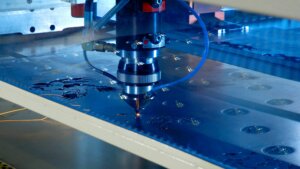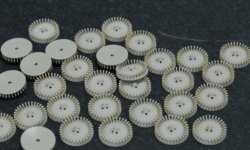In the realm of precision manufacturing, micro machining stands as a revolutionary technique, reshaping how we approach fabrication at microscopic scales. This in-depth guide delves into the intricate world of micro machining, exploring its principles, applications, and the remarkable precision it brings to modern engineering.
What is Micro Machining?
Micro machining, a term synonymous with precision and ultra-fine detail, refers to a manufacturing process where material is removed from a workpiece on a micrometer scale. This technique is pivotal in producing micro components with high precision, crucial in industries like aerospace, medical devices, and electronics.
In micro machining, tools and methods are meticulously designed to handle dimensions and tolerances that conventional machining can’t achieve, marking a significant leap in fabrication capabilities.
What is the Historical Evolution of Micro Machining?
The journey of micro machining from a niche concept to a cornerstone of modern manufacturing is a testament to human ingenuity and technological advancement. Originating in the mid-20th century with the advent of computer numerical control (CNC) technology, micro machining evolved through decades of research and innovation.
The progression from basic mechanical micro machining to sophisticated methods like Micro Electrical Discharge Machining (EDM) and Micro Laser Beam Machining (LBM) reflects the industry’s relentless pursuit of finer, more precise techniques.
How does Micro Machining work?
At its core, micro machining operates on the principle of material removal. Whether through mechanical, thermal, or chemical processes, the technique involves selectively eliminating material from a workpiece to achieve desired geometries and features. The precision of micro machining is facilitated by advanced machines, like high-precision CNC milling machines and micro EDM systems, which can maneuver tools and materials with exceptional accuracy.3
How Does Micro Machining Differ from Conventional Machining?
Micro machining distinguishes itself from conventional machining through its unique capabilities and applications:
- Precision and Scale: Micro machining achieves tolerances and features on a micrometer scale, far beyond the reach of standard machining.
- Tooling: Micro tools used in this process are significantly smaller and more precise, often requiring specialized handling and setup.
- Material Versatility: Micro machining can work with a broader range of materials, including metals, polymers, and composites, accommodating diverse industry needs.
- Applications: The technique is essential for industries demanding ultra-precision, like semiconductor manufacturing and medical device fabrication.
What Technologies Comprise Micro Machining Systems?
A range of advanced technologies comprises micro machining systems:
- Micro Machines: Includes high-precision CNC machines, micro EDM, and laser micro machining systems.
- Tools: Micro tools are designed for precision and can include end mills, drills, and abrasive particles.
- CAD/CAM Software: Used for designing and programming the machining processes, allowing for intricate and precise control.
- Feedback and Control Systems: High-resolution feedback systems are vital for accuracy, controlling the movement of tools and workpieces.
What are the Methods of Micromachining?
The realm of micro machining encompasses various techniques, each suited to specific applications and materials, contributing significantly to the field’s versatility and precision.
Mechanical Micro Machining
Mechanical Micro Machining is a precision engineering process used to create minute, intricate features on workpieces.
Micro Milling
- Involves the use of tiny cutters to sculpt complex geometries.
- A go-to method for detailed features, leveraging CNC machines for unparalleled precision.
- Ideal for creating intricate parts with complex shapes and geometries.
- Enables the production of micro molds, channels, and other detailed structures.
Micro Turning
- A scaled-down version of traditional turning, this technique excels in producing miniature cylindrical parts.
- Crucial in sectors like medical devices, aerospace, and precision engineering.
- Capable of achieving high surface quality and dimensional accuracy on small-scale workpieces.
- Often combined with micro milling for enhanced functionality and design flexibility.
Micro Drilling
- Specialized for creating highly precise, minuscule holes.
- A staple in electronics manufacturing, where every micron counts.
- Widely used in the creation of micro vias in PCBs and intricate components in microfluidics.
- Advanced versions incorporate laser and ultrasonic technologies for even greater precision.
Micro Grinding
- Utilizes fine abrasive particles, making it ideal for hard materials that require smooth surface finishes.
- Essential in producing optical components, micro lenses, and other precision parts.
- Can achieve extremely fine surface finishes, critical in applications where surface quality is paramount.
- Often used in tandem with other micro machining processes for final surface refinement.
Micro Ultrasonic Machining (Micro-USM):
- Merges ultrasonic vibrations with an abrasive slurry to effectively work on hard, brittle materials.
- Particularly effective for materials like ceramics, glass, and hard metals that are difficult to machine conventionally.
- Utilized in the fabrication of complex shapes and features in semiconductor and MEMS (Micro-Electro-Mechanical Systems) manufacturing.
- Offers minimal thermal and mechanical stress on the workpiece, preserving material integrity.
Thermal Micro Machining
Thermal Micro Machining utilizes heat energy to remove material from the workpiece. It’s distinguished by its ability to process hard-to-machine materials with high precision. The heat source, typically focused and intense, selectively removes or modifies materials, making this method ideal for applications requiring intricate detail and high precision. This category includes several key techniques:
Micro Electrical Discharge Machining (Micro-EDM)
- Uses electrical sparks to shape hard metals, perfect for intricate designs that mechanical methods can’t achieve.
- Micro-EDM is particularly adept at producing complex shapes with high aspect ratios.
- Essential for manufacturing micro molds, dies, and precision components.
- Ideal for materials such as titanium, alloys, and superconductors.
Micro Laser Beam Machining (Micro-LBM)
- A versatile method using focused laser beams, suitable for a variety of materials and intricate patterns.
- Can process a wide range of materials, including metals, plastics, and ceramics.
- Particularly useful in the semiconductor industry for circuit board production.
- Offers the capability to create micro-scale features with high aspect ratios.
Micro Electron Beam Machining (Micro-EBM)
- Employs electron beams for ultra-precise material removal, essential in high-precision applications.
- Unmatched in producing micro-sized features with complex geometries.
- Commonly used in the aerospace and medical industries for critical components.
- Allows for high processing speeds and minimal heat-affected zones.
Chemical and Electrochemical Micro Machining
This category of micromachining utilizes chemical and electrochemical reactions for material removal, providing distinct advantages in precision and surface finish.
Chemical Micro Machining
- Involves controlled chemical reactions for etching fine features, often employed in micro-fabrication processes.
- Particularly effective for producing micro-scale features on metals, glass, and silicon.
- Utilized extensively in semiconductor industry for creating intricate circuit patterns.
- Offers a non-contact method, eliminating mechanical stress on the workpiece.
Electrochemical Micro Machining (ECMM)
- Uses anodic dissolution in an electrolytic solution, allowing for precision machining without thermal stress.
- Ideal for shaping metals and alloys with high hardness and strength.
- Enables production of complex shapes with smooth surface finishes.
- Used in producing micro-components in aerospace, medical, and automotive industries.
Hybrid Micro Machining
Hybrid micro machining represents an innovative fusion of different machining processes, tailored to leverage the unique benefits of each method to enhance overall machining performance and precision.
Combined Hybrid Micro Machining
- Integrates different micro machining processes, exploiting each method’s unique advantages.
- Facilitates the creation of complex geometries that are difficult to achieve with a single method.
- Often combines mechanical and thermal processes to improve efficiency and surface quality.
- Used in precision engineering to produce parts with complex features and high aspect ratios.
Assisted Hybrid Micro Machining
- Merges primary micro machining with auxiliary processes, like ultrasonic or thermal assistance, to enhance capabilities.
- The auxiliary process often modifies the workpiece material properties temporarily, enabling easier machining.
- Enhances the material removal rate and reduces tool wear, leading to cost-effective manufacturing.
- Ideal for applications requiring high precision and surface quality, such as in aerospace and medical device manufacturing.
Other Methods
Exploring the diversity of micromachining, several innovative methods have been developed to meet specific industrial needs and challenges.
Micro Abrasive Jet Machining (Micro-AJM)
- Utilizes high-velocity abrasive particles, effective for material erosion.
- Perfect for machining brittle materials like glass and ceramics without inducing thermal damage.
- Capable of producing intricate features with a high degree of accuracy and minimal force.
Micro Focused Ion Beam Machining (Micro-FIB)
- Involves ion beams for precise milling or material deposition, showcasing the diversity and adaptability of micro machining techniques.
- Often used in semiconductor manufacturing for repairing masks and editing integrated circuits.
- Allows for highly localized machining, essential in nanotechnology and MEMS (Micro-Electro-Mechanical Systems) fabrication.
What CNC Machines Are Used in Micromachining?
The success of micro machining largely depends on the capability of CNC machines used in the process:
High-Precision CNC Milling Machines
- Features: Equipped with high-speed spindles, fine-resolution encoders, and advanced control systems for precise milling operations.
- Application: Ideal for crafting complex geometries and intricate parts in various materials.
CNC Turning Centers
- Features: Miniaturized versions of traditional lathes enhanced for high precision.
- Application: Specialized in producing small, cylindrical parts with tight tolerances.
CNC Swiss-Type Lathes
- Features: Renowned for their precision and capability to work with extremely small diameters.
- Application: Commonly used in medical and electronics industries for manufacturing tiny, complex components.
Ultra-Precision CNC Machines
- Features: Incorporate advanced motion control systems and thermal stabilization for sub-micron level accuracy.
- Application: Used in fields where ultra-high precision is paramount.
Micro EDM Machines
- Features: Utilize electrical discharges or sparks, equipped with fine wire electrodes for detailed machining.
- Application: Suitable for machining hard materials like titanium, often used in mold, die-making, and intricate part production.
Laser Micro Machining Systems
- Features: Employ highly focused laser beams for precise material removal or modification.
- Application: Versatile in micro cutting, drilling, and engraving across various materials.
CNC Grinding Machines
- Features: Equipped with high-speed spindles and fine abrasive wheels for micro grinding operations.
- Application: Achieve fine finishes and precise dimensions on hard materials.
Desktop or Benchtop CNC Machines
- Features: Compact and suitable for small-scale or prototype work.
- Application: Accessible for small businesses and educational settings, yet capable of high precision.
Special Features in CNC Micromachining Machines:
- Enhanced Vibration Control: Essential for maintaining accuracy at small scales.
- Thermal Stability: Prevents dimensional inaccuracies due to temperature fluctuations.
- High-Resolution Feedback Systems: Ensure precise control of tool movements.
- Automated Tool Changers: Efficiently handle the small and delicate tools used in micromachining.
What Materials Are Suitable for Micro Machining?
The choice of materials in micro machining is critical, with each material offering unique properties suitable for various applications. Here’s a rundown of commonly used materials, along with specific uses in micro machining:
Metals
- Stainless Steel: Known for its strength and corrosion resistance, stainless steel is ideal for medical devices, including surgical instruments and orthopedic implants. Its durability and ability to be sterilized make it a top choice in healthcare.
- Titanium: Offers a high strength-to-weight ratio and is used in aerospace for components like engine parts and airframe structures due to its resistance to corrosion and extreme temperatures. In medical applications, titanium’s compatibility with body tissues makes it suitable for implants and prostheses.
- Copper: Renowned for its excellent electrical conductivity, copper is commonly used in electronics for components like printed circuit boards (PCBs) and heat sinks. Its thermal conductivity also makes it ideal for cooling systems.
Plastics:
- Polymers like Polycarbonate and ABS: Chosen for their ease of machining and versatility, these plastics are used in consumer electronics for components like smartphone bodies, and in automotive applications for interior parts. They offer a good balance of strength, thermal stability, and aesthetic appeal.
Ceramics
- Alumina and Silicon Carbide: These materials are favored for their hardness and thermal resistance. Used in high-wear applications like semiconductor fabrication equipment and precision bearings, they can withstand harsh environments while maintaining dimensional stability.
Composites
- Carbon Fiber Reinforced Plastics (CFRP): Known for their strength and lightweight properties, CFRP materials are used in advanced engineering applications like aerospace for structural components, automotive for racing components, and sports equipment for improved performance due to their high strength-to-weight ratio.
What Are the Primary Applications of Micro Machining?
Micro machining’s precision and capability to work with a variety of materials make it indispensable in numerous industries. Here are some of its primary applications:
- Electronics: Micro machining is critical for manufacturing intricate micro components like circuit boards, sensors, and connectors. It allows for the creation of detailed features essential in miniature electronic devices, contributing to the miniaturization trend in electronics.
- Medical Devices: In this sector, micro machining is used for creating complex and highly precise implants, such as stents and orthopedic inserts, as well as surgical tools. These applications often require biocompatible materials, and the precision of micro machining ensures the safety and efficacy of these devices.
- Aerospace: The aerospace industry relies on micro machining for producing small, high-precision components like fuel injectors, control mechanisms, and components of avionics systems. The accuracy and precision of micro machining are essential for ensuring the reliability and performance of aerospace components.
- Automotive: Micro machining contributes to the development of miniature components used in modern vehicles, such as sensors for safety systems, components for electric vehicles, and intricate parts of the fuel injection systems. These components often require high precision to enhance the efficiency and performance of vehicles.
- Optics: This field uses micro machining for crafting small-scale lenses, mirrors, and components of optical devices. The ability to produce smooth surface finishes and precise geometries is vital for the performance of optical products.
- Telecommunications: In telecommunications, micro machining is used for fabricating components of communication devices, like fiber optic connectors and micro-scale antennas. These applications require precision and consistency, which micro machining provides.
- Research and Development: Micro machining plays a crucial role in the prototyping and development of new products across various sectors, including nanotechnology and new material development. The ability to work with a wide range of materials and create complex geometries makes it invaluable in research and development.
- Watchmaking: The watchmaking industry, especially in luxury and precision watches, uses micro machining for creating small, intricate components like gears, escapements, and other mechanisms. The high level of detail and precision required in watch components makes micro machining an ideal process.
- MEMS (Micro-Electro-Mechanical Systems): Micro machining is fundamental in MEMS manufacturing, which includes sensors, actuators, and microscale devices. These components are often used in consumer electronics, medical devices, and automotive systems.
What Are the Advantages and Limitations of Micro Machining?
Micro machining, a pivotal technique in precision manufacturing, comes with its own set of advantages and limitations:
Advantages
- Precision: Offers unparalleled accuracy, achieving features and tolerances in the micrometer and even sub-micrometer range.
- Versatility: Suitable for a diverse range of materials, from metals to polymers and ceramics.
- Complex Geometries: Capable of producing intricate and complex parts which are otherwise impossible with conventional machining.
- Reduced Waste: Minimizes material wastage, enhancing cost-effectiveness and environmental sustainability.
- Customization: Ideal for bespoke manufacturing, meeting the demands of various industries from medical to aerospace.
Limitations
- Cost: High initial investment in specialized equipment and training.
- Complexity of Operation: Requires highly skilled operators and precise control.
- Equipment Size: Some micro machining tools are large and require controlled environments, impacting the facility requirements.
- Maintenance: High-precision tools demand regular maintenance and calibration.
How Small Is a Micrometer in the Context of Micro Machining?
In micro machining, the scale of a micrometer (micron) is crucial for understanding the level of precision. A micrometer is one-millionth of a meter (0.001 millimeters), representing the minuscule dimensions that micro machining can accurately handle.
This level of precision allows for the creation of extremely small and intricate features on workpieces, essential in industries where miniature, high-precision components are required.
Is Micro Machining Expensive?
The cost of micro machining is influenced by several factors:
- Initial Investment: The specialized equipment required for micro machining, such as high-precision CNC machines and laser systems, represents a significant investment.
- Operation Costs: The operation of these machines requires skilled labor and regular maintenance, adding to the overall expense.
- Material Costs: Depending on the complexity of the tasks and the materials used, costs can vary.
- Long-term Benefits: Despite the higher initial cost, micro machining offers long-term savings through material efficiency, reduced waste, and the ability to produce complex parts that might be more expensive using traditional methods.
What are the Tolerances for Micro Machining?
The ability to achieve extremely tight tolerances is a defining feature of micro machining. These tolerances, however, vary based on the method used, the material being machined, and the complexity of the part.
General Tolerances
- Overall Range: Micro machining typically achieves tolerances ranging from ±0.001 mm (±1 micron) to ±0.005 mm (±5 microns), showcasing its precision.
- High-Precision Tolerances: In specialized applications, particularly with advanced equipment and optimal conditions, tolerances can be as tight as ±0.0001 mm (±0.1 micron).
Method-Specific Tolerances
- Micro Milling: Generally reaches tolerances around ±0.005 mm, but with high-precision setups, these can be tighter.
- Micro Electrical Discharge Machining (Micro-EDM): Known for very tight tolerances, often within ±0.001 mm to ±0.003 mm range.
- Micro Laser Beam Machining (Micro-LBM): Tolerances vary based on the laser’s power and precision, typically falling within ±0.005 mm to ±0.01 mm.
- Micro Ultrasonic Machining (Micro-USM): Offers tolerances around ±0.005 mm, influenced by the material and tooling used.
- Chemical and Electrochemical Processes: These methods can achieve very fine tolerances, often around ±0.001 mm, due to their controlled nature of material removal.
Factors Influencing Micro-Machining Tolerances
- Material Properties: Harder and more brittle materials may present challenges in maintaining tight tolerances.
- Tooling Precision: The quality and precision of tools and machines play a crucial role.
- Workpiece Stability: Any thermal expansion or vibration can impact final tolerances.
- Machining Environment: External conditions like temperature and humidity can affect the machining process and outcomes.
Industry-Specific Tolerances:
- Electronics and Semiconductors: Often require extremely tight tolerances, sometimes even in the sub-micron range.
- Medical Devices: Demand high precision, with tolerances frequently below ±0.002 mm.
- Aerospace: While precision is crucial, tolerances might be slightly less stringent than in semiconductor applications.
What Are the Key Factors in Micro Machining Precision?
Precision in micro machining is influenced by several critical factors:
- Speed and Feed Rates: These must be meticulously managed to ensure accuracy and minimize tool wear.
- Tooling: The quality, shape, and material of micro tools are pivotal in achieving desired outcomes, especially in terms of surface finishes and dimensional accuracy.
- Material Properties: Different materials respond differently to micro machining processes, affecting the precision and quality of the final product.
- Machine Stability: High-precision CNC machines, often equipped with vibration control and thermal stability systems, are essential to maintain the accuracy of the machining process.
What Challenges Are Faced in Micro Machining and How Are They Overcome?
Several challenges are inherent in micro machining, but with the right approaches, they can be effectively managed:
- Tool Wear: Due to the miniature size and precision of micro tools, they are susceptible to rapid wear. Using high-quality, wear-resistant materials and optimizing machining parameters can mitigate this.
- Material Sensitivity: Some materials may be prone to damage or deformation. Careful selection of machining methods and parameters tailored to specific material properties can help overcome this challenge.
- Burr Formation: Managing and minimizing burrs in micro machining is crucial. Techniques such as using sharp, well-maintained tools and optimizing cutting parameters are effective strategies.
Tips How to Troubleshoot Common Issues in Micro Machining Processes?
Effective troubleshooting in micro machining can significantly enhance the quality and efficiency of the process. Here are some practical tips:
- Regular Inspection: Frequently inspect tools for wear or damage to maintain consistent quality.
- Parameter Optimization: Adjust speeds, feeds, and depth of cut based on the material and desired outcome.
- Cooling and Lubrication: Proper use of coolants or lubricants can reduce heat generation and improve tool life and part quality
How do you choose the right equipment for micromachining?
Selecting the appropriate equipment for micro machining involves several considerations:
- Material Compatibility: Ensure the machine’s capabilities align with the types of materials you plan to process. For instance, a company specializing in aerospace parts may require machines that can handle high-strength alloys, such as titanium or Inconel.
- Precision Requirements: Match the machine’s precision capabilities with the tolerances required for your applications. A medical device manufacturer might need equipment capable of producing features with micron-level precision for intricate surgical tools.
- Size and Complexity: Consider the size and complexity of the parts to be machined. A micro machining center used by an electronics firm for producing miniature connectors will require different specifications compared to a manufacturer creating larger precision automotive components.
- Software Integration: Ensure compatibility with CAD/CAM software for streamlined operations. An optics manufacturer, for instance, may use specialized software to design complex lens geometries, necessitating compatible micro machining equipment for production.
- Tooling Flexibility: Select equipment that can accommodate a variety of micro tools, which is crucial for businesses like watchmakers who need to create a range of intricate components.
- Speed and Efficiency: For high-volume production environments, such as in the semiconductor industry, equipment speed and efficiency can significantly impact throughput and profitability.
- Customization Options: Some applications may require customized machine solutions. A case in point could be a research lab working on microfluidic devices, needing specialized micro machining setups.
- After-Sales Support and Training: Ensure the availability of comprehensive after-sales support and training. A company venturing into advanced micro machining for the first time will greatly benefit from robust training and ongoing support.
- Footprint and Ergonomics: Especially important for small workshops or labs, like those in academic settings, where space is at a premium and ease of use is critical.
- Cost-Benefit Analysis: Weigh the cost of the equipment against the expected benefits and return on investment. A small startup making innovative MEMS devices would need to carefully balance the initial investment with potential market growth.
- Energy Efficiency: With growing concerns about sustainability, selecting energy-efficient machines can be crucial, as seen in environmentally conscious sectors like renewable energy component manufacturing.
- Scalability: Consider how the equipment will fit into long-term growth plans. A startup in the field of micro-optics might start with smaller, less automated machines and plan for more advanced systems as the business scales.
How Does Environmental Sustainability Interact with Micro Machining?
Micro machining intersects with environmental sustainability in various ways:
- Reduced Material Waste: Precise machining minimizes material wastage.
- Energy Efficiency: Advances in machine design focus on reducing energy consumption.
- Recycling of Materials: Emphasis on the recyclability of scraps and micro components.
- Sustainable Practices: Incorporation of eco-friendly practices in manufacturing processes.
Conclusion
Micro machining represents a significant leap in manufacturing technology, offering unparalleled precision and flexibility. Its impact extends across various industries, driving innovation and efficiency. As technology advances, micro machining will continue to play a crucial role in shaping the future of manufacturing, pushing the boundaries of what is possible in miniaturization and precision engineering.













